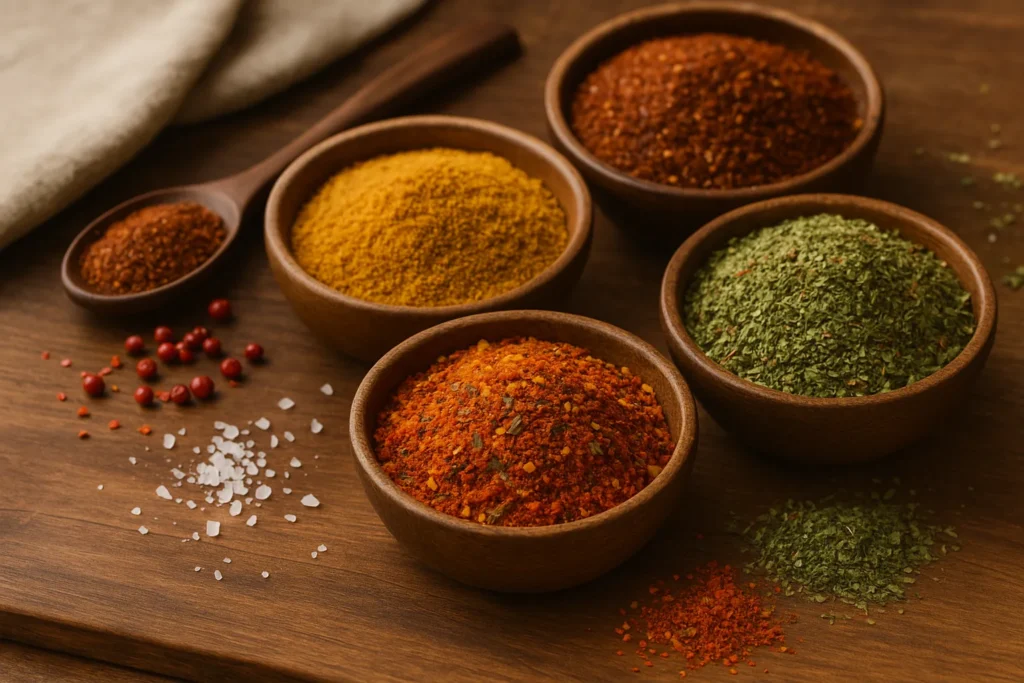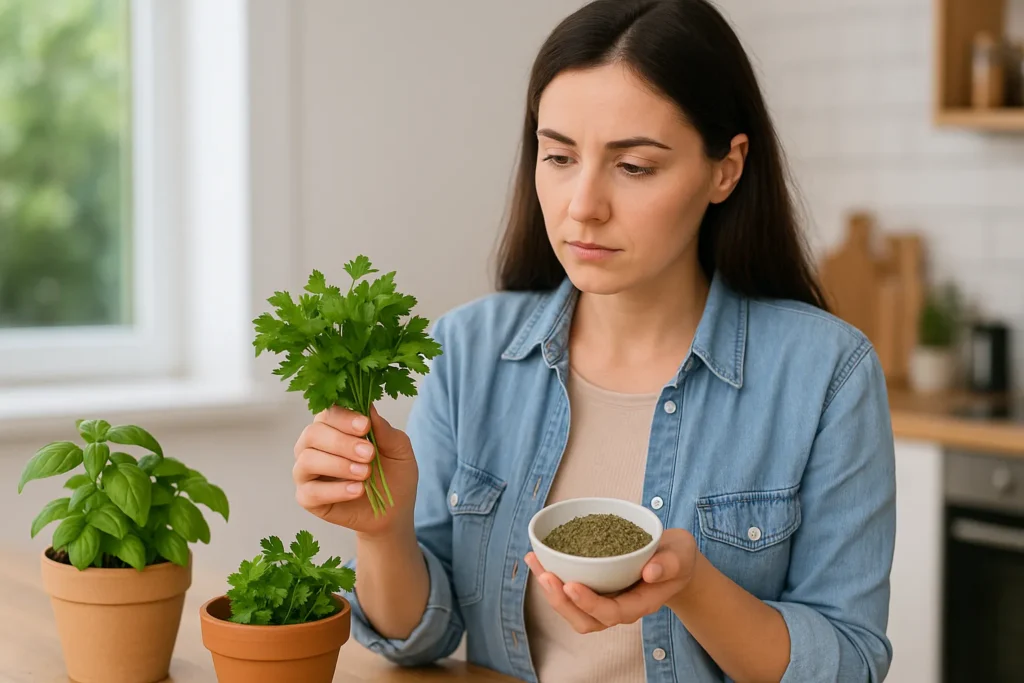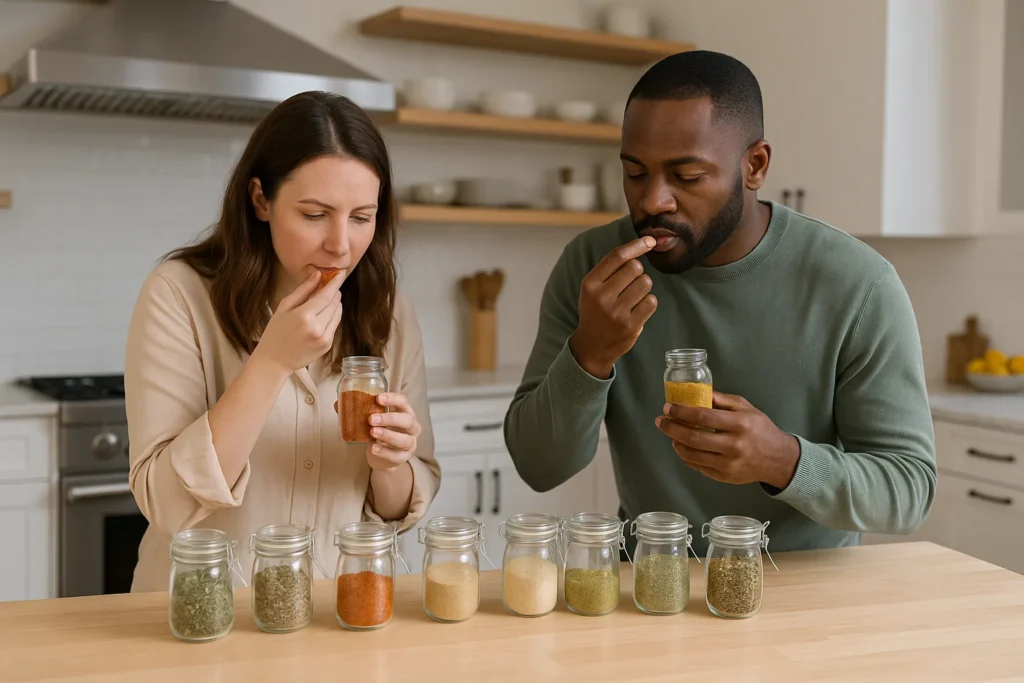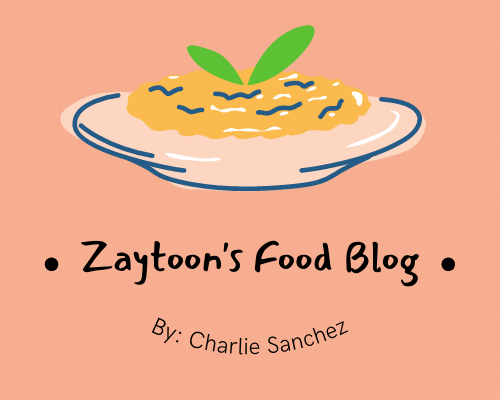Middle Eastern spices bring bold flavour to simple ingredients. They help turn basic foods into savoury dishes you’ll want to make again. Cumin, coriander, and turmeric each add something unique and work well together in the same pot.
These spices balance sweetness, heat, and depth. They’ve been used for generations to build recipes that are full of warmth and meaning.
In this guide, you’ll explore the world of spices with clear steps. You’ll learn how to use them in your meals, when to add them while cooking, and which ones to start with first.
Let’s begin.
Easy Spice Mixes to Start With
Spice mixes are your shortcut to tasty food with less guesswork. Instead of opening six jars and hoping for the best, you use one mix that’s already balanced for you. These spice combinations have stood the test of time.
Here are three go-to mixes worth keeping in your kitchen:

- Za’atar: A tangy, nutty mix of dried thyme, sesame seeds, sumac, and salt. Think of it as a Middle Eastern finishing move. Dust it over hummus, yoghurt, or even scrambled eggs. Toss it on flatbreads before baking, and you’ll never go back to plain dough again.
- Baharat: This warm, all-purpose seasoning is sometimes called “Middle Eastern allspice,” but it’s a mix, not a single spice. It often includes cinnamon, coriander, black pepper, and cloves. Use it in tomato sauces, beef mince, or lentil soups. It gives stews that comforting, deep taste you usually get after hours of simmering.
- Ras el Hanout: This blend means “head of the shop,” and it lives up to the name. It’s often made with over 10 spices, including cardamom, ginger, and nutmeg. Great for slow-cooked lamb, chickpea tagines, or even stirred into couscous. The result is bold, layered, and slightly mysterious in a good way.
Tip: Choose one mix and use it in three dishes this week. You’ll figure out what it adds and how much your taste buds can handle.
Key Single Spices You Need
Middle Eastern cooking doesn’t rely on dozens of fancy ingredients. It relies on using the right spices in the right way. These five are simple, powerful, and worth getting to know.
Cumin
This is the quiet hero in many Middle Eastern dishes. It’s earthy, a bit smoky, and brings warmth that sticks around. Toast the seeds before grinding, or bloom the powder in oil to wake it up. Try it in falafel, lentil stew, or mixed into lamb kofta.
Turmeric
Known for its bright yellow colour, turmeric adds mild bitterness and a gentle earthiness. It mixes well with slow-cooked vegetables, rice dishes, or soups with lentils. When it’s mixed with oil and black pepper, it boosts its impact both in flavour and absorption.
Garlic Powder
Great when you want garlic without peeling anything. It brings savoury depth to chicken marinades, chickpea stews, or even dry rubs. It’s not loud, but it builds a foundation that other spices can rest on.
Cayenne Pepper
This one brings the heat fast. Use a tiny pinch in shakshuka, grilled meats, or harissa-style pastes. It gives dishes a controlled kick that sharpens the overall taste without blowing out your palate.
Black Pepper
Often overlooked, but essential. Ground fresh, it adds warm spice and connects flavours. Use it early in cooking for layering, or finish a dish with it to highlight the sharper notes.
Tip: These spices don’t compete, they collaborate. Start with one or two, then build up your own rhythm over time.
Fresh Herbs vs Dried Herbs: When to Use What
Not all herbs play the same role in cooking. Some bring brightness and a pop of freshness. Others give a deeper, slower flavour. Knowing when to use fresh herbs or reach for the dried jar can help you get more out of your dishes.

Here’s a quick comparison:
| Herb | Fresh | Dried | Use It Best For |
| Parsley | Bright, grassy, adds lift | Mild, less vibrant | Fresh in tabbouleh or salads, dried in soups |
| Mint | Cool and aromatic | Deeper and earthier | Fresh in dips and drinks, dried in rice dishes |
| Coriander | Sharp, citrusy | Warm and mellow | Fresh in grain bowls, dried in spice mixes |
| Thyme | Sharp and floral | Strong, woody | Fresh in quick sautés, dried in marinades or stews |
| Oregano | Zesty and peppery | More concentrated, less bright | Fresh in dressings, dried in tomato-based sauces |
How to Use Spices the Right Way
Using spices well comes down to timing, technique, and purpose. A bit of planning can help you bring out more aroma and deeper flavour in your meals.
Here’s how to get more out of what you already have in the kitchen.
Toast spices before using: Toasting wakes up whole spices like cumin, coriander, or fennel seeds. Place them in a dry pan over low heat for 30–60 seconds until you smell the aroma rising. Then grind them and use them in rice dishes, stews, or marinades. Toasted cumin is especially good in lentil soup or lamb kofta.
Bloom ground spices in fat: This technique is perfect for building depth in curries or tomato sauces. Add a teaspoon of spice like paprika or turmeric into hot oil or ghee at the start of cooking. Stir for 20–30 seconds before adding onions or garlic. It helps the spice cling to ingredients and releases maximum flavour.
Use fresh, not faded: Old spice loses its power. If the colour is dull or the smell is faint, it’s time to replace it. Most ground spices last 12–18 months if stored in an airtight container, away from heat and light.
Don’t add everything at once: Layer spices over time. Add a base of cumin and garlic powder early, and finish with black pepper or cayenne near the end. This works well in chickpea stew or spiced rice. It keeps flavours from blending into a flat mix.
Think of spices as tools, not extras: Spices set the tone for your food. They’re not just a final touch. They’re the determining factor in the balance, intensity, and feel of the dish.
According to a study published by Cambridge University Press, 64.8% of Australian participants use herbs and spices one to two times per day. That tells you just how central they are to everyday cooking.
Find Recipes and Try New Flavours
Start small. Pick one spice you haven’t cooked with before and search for two or three simple recipes that use it well. When you find recipes that work, you’ll start to build confidence and meals that taste better.
Don’t worry about mastering the full spice rack. Focus on learning what one new flavour adds to your food. For example, notice how sumac adds sharpness to a tomato salad, or how cinnamon deepens the flavour of a lamb stew. Your goal isn’t to impress anyone. It’s to understand how different spices behave in real dishes.
Use what you already know how to cook. Many Middle Eastern recipes are similar to meals you already make: stews, rice, and roasted vegetables. What changes is the seasoning. That’s how you introduce your taste buds to something new without overwhelming them.

If you’re unsure where to begin, look for recipes with short ingredient lists and one featured spice. These are easier to follow and make it simpler to identify what each spice is doing in the dish.
Spices Bring Culture to the Table
Every time you cook with spices, you connect with something bigger than the meal in front of you. These flavours carry stories, travel across generations, and add meaning to the simplest ingredients.
Middle Eastern spices help you create meals that feel rich and familiar, even if it’s your first time trying them. You don’t need to know everything to get started. You just need curiosity and a few good jars.
Cooking is one of the simplest ways to explore the world from your own kitchen. Try one recipe, then another. Notice how the flavour changes with a small adjustment.
For ideas and easy-to-follow inspiration, head over to Zaytoon’s Food Blog. It’s a helpful space to keep learning and cooking.

